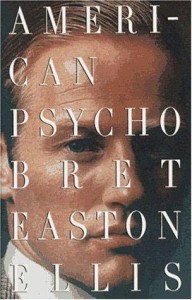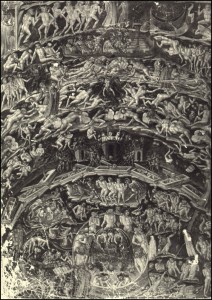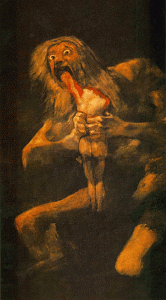As Stephen King once wrote:
Let’s talk about fear, you and I. Let’s talk about fear.
But not just any fear. King already beat me to talking about fear in written fiction (though that doesn’t stop me from going at it every so often, of course) and King already beat me to talking about fear on film (again, something I occasionally have made a foray into). But I want to talk about a type of fear — a variety of what Noel Carroll calls “art-horror” — that King doesn’t take into account in his Danse Macabre, and which Caroll (as I recollect) does not even mention in his own treatment of the genre.
I want to talk about theatric horror.

There are two ways you might respond to the idea of theatric horror. The first is that it is ridiculous: a man wearing a bedsheet onstage is an actor playing the ghost of Old Hamlet, and nothing more; it is (this line of thinking implies) silly to be scared by anything onstage because, quite paradoxically, all of it is illusory, so anything that appears unnatural (like a ghost) is, in fact, naturally explicable (a man in a bedsheet). The other way to think about it is that theatric horror should be about the same as cinematic horror, that if you can be scared of Jason Voorhees on a screen then you damn sure can be frightened by a man wearing a bedsheet.
The key thing to take from both of these examples is that both make the assumption that horror is participatory. This is no big revelation; all fiction is participatory in varying capacities. This mostly takes the form of making the viewer/reader/audience’s desires the same as one or some of the characters’ desires. It’s about interest, and it’s about sympathy. You want to know why Old Hamlet’s ghost is stalking the battlements, if it’s telling the truth or not; you want Elizabeth and Mr. Darcy to get together; you want to figure out what the fuck is going on with that island and the polar bear and the time-travel and you hope to god it all makes sense in the end.
But horror is special.
You don’t want the zombie apocalypse to happen — and listen, I know it’s fashionable to be excited about zombies and the end of the world, but trust me, almost everyone who insists on proclaiming they’ll have a good time when the shit hits the fan will be among the first to either die or become a quivering, sobbing mess. This is what Noel Carroll calls the paradox of horror: it is a genre set up specifically to show us things we hate or despise, things designed to make us unhappy, and we flock to it. So yes, horror is participatory, but it is participatory in a way that is distinct from the way other genres are. The closest thing to it is tragedy, which generally focuses on a handful of repulsive things, but by definition there is a catharsis, a final release of tension; horror, on the other hand, has no such obligation. At the end of, say, The Blair Witch Project, the story doesn’t actually end. It just stops; the monster is still on the loose, there is no return to order.
The idea is that horrific things do not end, terror does not end, and above all, you are subject to the same fears and forces that govern the lives of the characters. The toys and props of horror aren’t put neatly back into the box and hidden away at the end of the game; they continue to litter floor, and you step on them in the middle of the night when you least expect it.
So horror, despite its paradoxes, is quite a participatory thing indeed. And it should be noted that of the modes of storytelling I’ve brought up — fiction, film, television, theater — it is the latter that is the most participatory. After all, it’s not words on a page and it’s not an interplay of light from a projector — things are happening there in front of you, and it’s the closest you can get to it actually happening. Given the participatory nature of horror and the participatory nature of theater, the two ought to be a match made in heaven.
So how do you make a play scary?
I’ve recently seen two horror plays, and the remainder of this blog entry will be me outlining the way each production attempts to develop an atmosphere and, above all, a feeling of terror in the audience — the percipients. A percipient being, of course, one who perceives; it’s also a pseudotechnical term tossed around by some parapsychologists to describe those who ‘perceive’ themselves as having had supernatural experiences. Added to that, it sounds fortuitously similar to participant, and in case you couldn’t tell, that’s going to be a cornerstone of my discourse.
Now: Play number one. The Woman in Black, currently running at the Fortune Theatre in Covent Garden, a few blocks from where I work. This thing has been on forever — for me, almost literally, since it’s been going nonstop since 1989, when I was barely a year old. It’s been through its share of actors, too — the cast in that trailer the website is running is a completely different cast from the one I saw. That’s a notable, if tertiary, facet of the play: it has a cast of two. Three, maybe, but then things get a little complicated. I’ll explain that in a bit.
 WiB is obviously a pretty successful venture, having run for 21 years, and I personally think it mostly succeeds as a play and as a piece of horror fiction. I’m not going to say it frightened me — it didn’t, I don’t frighten easily — but the people in the audience who kept screaming seemed pretty scared. Of course, the people who were screaming were mostly teenaged schoolgirls — the curse of the matinee showing, from what I hear — and they were screaming at the ‘jump-scare’ bits, things like doors slamming and so on. I’m not going to fault the play for that. I tend to look down on jump scares in film only when they are predictable and when they are the only mechanism used (or overused); suffice it to say that WiB‘s jump scares are very often unpredictable and they only become grating if, like me, you have to listen to a few dozen sixteen year old girls shouting every time.
WiB is obviously a pretty successful venture, having run for 21 years, and I personally think it mostly succeeds as a play and as a piece of horror fiction. I’m not going to say it frightened me — it didn’t, I don’t frighten easily — but the people in the audience who kept screaming seemed pretty scared. Of course, the people who were screaming were mostly teenaged schoolgirls — the curse of the matinee showing, from what I hear — and they were screaming at the ‘jump-scare’ bits, things like doors slamming and so on. I’m not going to fault the play for that. I tend to look down on jump scares in film only when they are predictable and when they are the only mechanism used (or overused); suffice it to say that WiB‘s jump scares are very often unpredictable and they only become grating if, like me, you have to listen to a few dozen sixteen year old girls shouting every time.
Where the play succeeds most admirably, I think, is the more insidious horror it attempts to instill through use of atmosphere and two or three wonderfully executed images. My favorite was the titular woman in black, lying corpse-still in a madly careening rocking chair which then threw her forward with such force that she seemed to fly and, without any misstep, landed on her feet (assuming she has feet, below her tattered skirts) to glide soundlessly across the stage.
The plot is often billed as being an MR Jamesian ghost story, which is half a truth and half a lie. James’s ghost stories have a very particular pattern and a particular way of presenting the supernatural that is wholly absent in the play; where the two more happily coincidence, however, is in the manner of narration. I have a love-hate relationship with Jamesian narration; it seems like sometimes he just decided to be as fucking roundabout as he could in getting to the story he had to tell.
In order to create what he called a “pretense of truth” he often sets up webs of narrators to tell a single story.
A typical James story will be narrated by the first-person-I, a scholar or antiquarian who is presumably James himself; this narrative voice will do such wonderful things as tell us, rather blatantly, that he is not telling us everything he can so that he may explain details more chillingly later, or he may off-handedly dismiss a secondary character as nameless because he’s just not important to the story. Below the James-narrator there is often a second voice belonging, supposedly, to one of his friends or acquaintances, to whom the events of the story occurred; though James will talk about the character in third person, his narrative voice occasionally gives way to the other character’s first person narration of the events in question. The secondary narrator, for his (and it’s almost always his) part will often find an old manuscript — a court transcription, a diary, whatever — that also relates events in the first-person voice of someone who is long dead, often providing a clue as to the nature of the hauntings. The text-within-the-narration, with its archaic syntax and occasional rambling passages in Latin, will often consume a large portion of the narrative structure.
If this all sounds a bit complicated, trust me when I say that it is. Sometimes James gets so caught up with himself it’s impossible to tell who is narrating what and when and how. If you’re also thinking this all sounds awfully postmodern, keep in mind that James was writing in the 1900s, and had no real reason to be this damn complicated. His narrators are like nightmarish Russian nesting dolls, each one trapped inside the other and more removed from the reader than the last.
Now, The Woman in Black very admirably follows up on this tradition of being obfuscating as fuck by having the same narrative confusion, but on stage.
 It works something like this: an older man, sort of bumbling, wants to tell a story to lay his conscience to rest. He consults an actor, the other main character, to help him work on his public speaking skills for this purpose. The older guy, Arthur Kipps, is a terrible speaker, though, and so the actor (who finds the story interesting and has designs on making it a play) takes over Arthur’s role for the purposes of flashback. So right there on stage, one character literally becomes the other, a lighting change telling you that you’ve entered a flashback. The real Arthur, for his part, becomes every other character in the play, changing his outfit or glasses slightly and affecting multiple accents to fill various roles. So then suddenly you’re not watching these two guys put on a play about Arthur’s experience, you’re actually watching the memory — until, for one reason or another, we jump back and Arthur turns into the actor and the other actor turns back into Arthur.
It works something like this: an older man, sort of bumbling, wants to tell a story to lay his conscience to rest. He consults an actor, the other main character, to help him work on his public speaking skills for this purpose. The older guy, Arthur Kipps, is a terrible speaker, though, and so the actor (who finds the story interesting and has designs on making it a play) takes over Arthur’s role for the purposes of flashback. So right there on stage, one character literally becomes the other, a lighting change telling you that you’ve entered a flashback. The real Arthur, for his part, becomes every other character in the play, changing his outfit or glasses slightly and affecting multiple accents to fill various roles. So then suddenly you’re not watching these two guys put on a play about Arthur’s experience, you’re actually watching the memory — until, for one reason or another, we jump back and Arthur turns into the actor and the other actor turns back into Arthur.
It all gets very confusing, as you might imagine; you never know if the people on stage are people “on stage” practicing their play in an empty theater or people in a haunted house, and the fact that they can go from one to the other at any time doesn’t help. When the ghost, the woman in black, finally shows up, is she actually there? Is she on the stage with Arthur and the actor, or is she part of a flashback, a memory? The implication, quite horrible indeed, is that if she is in fact on the stage in the play’s “present” then she is also there on stage in front of you. And since she operates sort of like Kiyoko from the Ju-On films — she passes on from person to person, seeking vengeance for the wrongs done to her in life — there’s the equally unsettling implication that the woman in black, if she is there, is now after you.
This is underscored by the play’s curtain call. As the audience applauds, the two actors you know quite well by now come out and bow, try to run back stage, come back to the continued applause, bow, and leave. Just them. Only those two.
And, after they have gone, the woman in black appears at the very back of the stage, just visible, staring out at you. She does not smile, she does not bow; she only stares. For her, it seems, the play is not over.
Then she disappears, and you’re free to go. Or so you think, anyway, but the play has already taught you that the woman in black can show up where you least expect her, be it an ancient house in the marshlands or a London park on a sunny afternoon.
We should also take time to consider the other play I saw, Ghost Stories at the Lyric Hammersmith. There are a few things to note about this play, the first being that it is new and has a modern day setting, unlike The Woman in Black, which was written in the 80s but takes place in the early 20th century. The second is that it is co-written and directed by Jeremy Dyson, one of the writers for a black comedy television program that is very near and dear to me, The League of Gentlemen. What this means is that the story is very consciously influenced by horror films and at certain points it becomes as bizarre as all get-out.
Ghost Stories is also the better of the two plays. I’m wary to talk much about it for fear of spoiling it — not that I expect anyone reading this to see it, really, but I am loath to give away the play’s secrets. In structure the plot works something like this: you are part of an audience watching a Dr. Goodman present a short seminar on ghost stories, which he collects from various people. As he replays recordings of these experiences to you, the audience, the action on the stage takes over and we “see” what is happening in flashback. There are in total three vignettes of this type, linked by Goodman’s lectures on them, giving the entire thing a sort of classic anthology movie feel — think Creepshow or something of that variety.
 The play’s resolution held no surprises for me, but it was well executed; I will not discuss it further, except to say that if The Woman in Black is an MR James story, then Ghost Stories follows, appropriately enough given Dyson’s own apparent interest, in the footsteps of Robert Aickman. Aickman is woefully under-read, I think, and this is not helped by the fact that his work is almost entirely out of print and very hard to find in any other way — in my travels through used bookstores here I found a shop that had two of his early collections (first editions, about £95 each) and both volumes of his collected ghost stories (£400). At any rate, there’s a quote from Neil Gaiman on that Wikipedia page that I feel gives a very accurate description of what it is like to read an Aickman story: as a reader, you are slowly overcome with a sense that something is horribly, terrifyingly wrong, and by the end you know it is, and yet afterward you can never figure out exactly what went wrong, where it went wrong, and how.
The play’s resolution held no surprises for me, but it was well executed; I will not discuss it further, except to say that if The Woman in Black is an MR James story, then Ghost Stories follows, appropriately enough given Dyson’s own apparent interest, in the footsteps of Robert Aickman. Aickman is woefully under-read, I think, and this is not helped by the fact that his work is almost entirely out of print and very hard to find in any other way — in my travels through used bookstores here I found a shop that had two of his early collections (first editions, about £95 each) and both volumes of his collected ghost stories (£400). At any rate, there’s a quote from Neil Gaiman on that Wikipedia page that I feel gives a very accurate description of what it is like to read an Aickman story: as a reader, you are slowly overcome with a sense that something is horribly, terrifyingly wrong, and by the end you know it is, and yet afterward you can never figure out exactly what went wrong, where it went wrong, and how.
Ghost Stories is less coy about the why and how parts of the equation, but it does indeed do an admirable job of slowly breaking down the audience’s complacency. In other words, while watching Ghost Stories, you think you’re seeing one thing, but you slowly begin to understand that you’re really witnessing something else entirely.
I’m sure that’s vague to the point of being useless, but it’s the way the play goes, and I really don’t want to say any more about it. They even ask you kindly after the show not to tell anyone! And, anyway, I hear John Landis was in the audience a few nights ago, which (if his career weren’t dead) might bode favorably for a film adaptation.
Except.
This isn’t a post about horror films. It’s a post about horror theater, and I sincerely believe that Ghost Stories could not work as a film. Neither could, I think, The Woman in Black, though the BBC apparently tried.
I have come to understand that the way theatric horror works — and the reason it is unique — is that the audience participates in a way completely unlike their participation with other genres and other forms. The common trend in both plays I’ve described is that the barrier between the audience, the percipient/participant, and the action on stage is broken down — the proscenium, the fourth-wall, is presented as permeable. You leave the Woman in Black thinking you might be her next victim, but you don’t leave a production of Oedipus Rex thinking you’re going to murder your dad and bone your mom. (At least I hope not.)

Likewise Ghost Stories, with its wraparound frame of a parapsychologist’s lecture, makes you personally a part of what is happening. It’s simpler than WiB‘s layering of narration, and while I actually think WiB is very clever and successful in that regard, it’s also a bit cold. Ghost Stories‘s technique is simpler, perhaps cruder, but far more effective in bringing the audience into the world of the play. In other words, while the former is a technical success, I believe the latter is a general success.
To go back to MR James, when writing on his ghost stories, he claimed his multiple narrators and pretense of truth were required to make the reader think, “If I’m not careful, this could happen to me!” This is the point of theatric horror, I think — even more so than a horror story or a horror film.
I also think this is why horror theater is not a widely considered part of the spectrum: it’s really easy to do it badly, so there’s not much of it. The percipients have to be participants in the fullest sense; they have to feel what is going on, they have to be sympathetic, because you (the writer/actor/director/whatever) are essentially asking them to make themselves feel intensely uncomfortable. It’s not a request many people are inclined to comply with, and if this sort of thing were to fail, it would do so spectacularly.
This may be a lot to base on only two plays, but it’s all I have to go on, so it’s the best I’ve got. It’s an allegation supported, I think, by the rather famous and experimental Punchdrunk company, who stage their plays in actual buildings, having the actors go about their business while the audience wanders around, observing and ignored. In other words, they do away with the proscenium entirely. From what I hear, Punchdrunk’s Faust was absolutely fucking terrifying.
Punchdrunk’s approach also underscores another observation I’ve made about theatric horror, and perhaps theater in general. You’ll recall that in The Woman in Black, part of the action takes place in an empty theater — the characters refer to the theater multiple times, talking about how empty it is. Of course this garners a few laughs, because the theater is not empty at all.
But it’s a rather uncanny notion, nonetheless — to be outright ignored by another human being, for him to pretend you don’t exist. There’s a similar sort of dynamic in Ghost Stories and — hell — I feel like the same sort of thing goes on in almost any play.

When theater works well, there’s always that uncanny feeling that you are in a place you shouldn’t be, that you have somehow become unseen or insubstantial. Horror plays tend to involve the audience more directly perhaps because the actors need your consent to make the monsters real, and so you’re invited, in a sense, to become part of the play.
In other words, in good theater, the audience should feel that they are real ghosts.

 WiB is obviously a pretty successful venture, having run for 21 years, and I personally think it mostly succeeds as a play and as a piece of horror fiction. I’m not going to say it frightened me — it didn’t, I don’t frighten easily — but the people in the audience who kept screaming seemed pretty scared. Of course, the people who were screaming were mostly teenaged schoolgirls — the curse of the matinee showing, from what I hear — and they were screaming at the ‘jump-scare’ bits, things like doors slamming and so on. I’m not going to fault the play for that. I tend to look down on jump scares in film only when they are predictable and when they are the only mechanism used (or overused); suffice it to say that WiB‘s jump scares are very often unpredictable and they only become grating if, like me, you have to listen to a few dozen sixteen year old girls shouting every time.
WiB is obviously a pretty successful venture, having run for 21 years, and I personally think it mostly succeeds as a play and as a piece of horror fiction. I’m not going to say it frightened me — it didn’t, I don’t frighten easily — but the people in the audience who kept screaming seemed pretty scared. Of course, the people who were screaming were mostly teenaged schoolgirls — the curse of the matinee showing, from what I hear — and they were screaming at the ‘jump-scare’ bits, things like doors slamming and so on. I’m not going to fault the play for that. I tend to look down on jump scares in film only when they are predictable and when they are the only mechanism used (or overused); suffice it to say that WiB‘s jump scares are very often unpredictable and they only become grating if, like me, you have to listen to a few dozen sixteen year old girls shouting every time. It works something like this: an older man, sort of bumbling, wants to tell a story to lay his conscience to rest. He consults an actor, the other main character, to help him work on his public speaking skills for this purpose. The older guy, Arthur Kipps, is a terrible speaker, though, and so the actor (who finds the story interesting and has designs on making it a play) takes over Arthur’s role for the purposes of flashback. So right there on stage, one character literally becomes the other, a lighting change telling you that you’ve entered a flashback. The real Arthur, for his part, becomes every other character in the play, changing his outfit or glasses slightly and affecting multiple accents to fill various roles. So then suddenly you’re not watching these two guys put on a play about Arthur’s experience, you’re actually watching the memory — until, for one reason or another, we jump back and Arthur turns into the actor and the other actor turns back into Arthur.
It works something like this: an older man, sort of bumbling, wants to tell a story to lay his conscience to rest. He consults an actor, the other main character, to help him work on his public speaking skills for this purpose. The older guy, Arthur Kipps, is a terrible speaker, though, and so the actor (who finds the story interesting and has designs on making it a play) takes over Arthur’s role for the purposes of flashback. So right there on stage, one character literally becomes the other, a lighting change telling you that you’ve entered a flashback. The real Arthur, for his part, becomes every other character in the play, changing his outfit or glasses slightly and affecting multiple accents to fill various roles. So then suddenly you’re not watching these two guys put on a play about Arthur’s experience, you’re actually watching the memory — until, for one reason or another, we jump back and Arthur turns into the actor and the other actor turns back into Arthur. The play’s resolution held no surprises for me, but it was well executed; I will not discuss it further, except to say that if The Woman in Black is an MR James story, then Ghost Stories follows, appropriately enough given Dyson’s own apparent interest, in the footsteps of
The play’s resolution held no surprises for me, but it was well executed; I will not discuss it further, except to say that if The Woman in Black is an MR James story, then Ghost Stories follows, appropriately enough given Dyson’s own apparent interest, in the footsteps of 


 If you’re in any way religious — particularly if you are Catholic — this may have echos of Ash Wednesday. If you’re a godless heathen, then the short of it is that Ash Wednesday is the first day of Lent, the period of penitence and fasting leading up to Easter. On Ash Wednesday, the penitents are marked by the priest with a cross of ashes on the forehead, a reminder that human beings come from dust and, but for the grace of God, they’ll someday be to the dust returned. In other words, it’s a humbling process, just as the journey through Dante’s Purgatory is meant to humble those souls that were sinful in life but not beyond hope.
If you’re in any way religious — particularly if you are Catholic — this may have echos of Ash Wednesday. If you’re a godless heathen, then the short of it is that Ash Wednesday is the first day of Lent, the period of penitence and fasting leading up to Easter. On Ash Wednesday, the penitents are marked by the priest with a cross of ashes on the forehead, a reminder that human beings come from dust and, but for the grace of God, they’ll someday be to the dust returned. In other words, it’s a humbling process, just as the journey through Dante’s Purgatory is meant to humble those souls that were sinful in life but not beyond hope.
 And from that, the conversation devolves into everyone arguing about where to eat, Price’s concerns left unaddressed. Even if something else seems to be bothering Price, he does seem to have a bone to pick with Reagan — what was he lying about? What sort of shit is he getting away with? I wasn’t watching much TV back then, but one possibility is that Reagan is speaking about the 1989 IRS investigation of him and his wife Nancy for unpaid taxes on various gifts they received while in the White House. It was eventually determined that the Reagans owed three million dollars on “fashion items” (to
And from that, the conversation devolves into everyone arguing about where to eat, Price’s concerns left unaddressed. Even if something else seems to be bothering Price, he does seem to have a bone to pick with Reagan — what was he lying about? What sort of shit is he getting away with? I wasn’t watching much TV back then, but one possibility is that Reagan is speaking about the 1989 IRS investigation of him and his wife Nancy for unpaid taxes on various gifts they received while in the White House. It was eventually determined that the Reagans owed three million dollars on “fashion items” (to 



 To put it quickly and simply, Pat Bateman is Macbeth. It’s so cleverly updated, I think, that it’s pretty easy
To put it quickly and simply, Pat Bateman is Macbeth. It’s so cleverly updated, I think, that it’s pretty easy to miss: one of Macbeth’s defining early characteristics is his insecurity, so Bateman constantly obsesses over what he is wearing in comparison to what everyone else is wearing, which stereo system is the best or most expensive and can he get one, and in one scene practically has a panic attack when he sees that a colleague has a more stylish business card. And just as Macbeth is prone to seeing things, so is Bateman, who imagines that Satan is speaking to him through Bono at a U2 concert, an anthropomorphic Cheerio is being interviewed on his favorite sensationalist talk show, a park bench is stalking him, and, in a scene launched into the general pop culture by the film version, an ATM wants him to feed it a stray cat.
to miss: one of Macbeth’s defining early characteristics is his insecurity, so Bateman constantly obsesses over what he is wearing in comparison to what everyone else is wearing, which stereo system is the best or most expensive and can he get one, and in one scene practically has a panic attack when he sees that a colleague has a more stylish business card. And just as Macbeth is prone to seeing things, so is Bateman, who imagines that Satan is speaking to him through Bono at a U2 concert, an anthropomorphic Cheerio is being interviewed on his favorite sensationalist talk show, a park bench is stalking him, and, in a scene launched into the general pop culture by the film version, an ATM wants him to feed it a stray cat.



 As it turns out, quite a lot. Let’s take a look at the very beginning of Ellis’s novel:
As it turns out, quite a lot. Let’s take a look at the very beginning of Ellis’s novel: 

